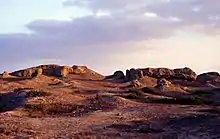Buto
Buto (Greek: Βουτώ, Arabic: بوتو, Butu),[1] Butus (Greek: Βοῦτος, Boutos)[2] or Butosus was an ancient city located 95 km east of Alexandria in the Nile Delta of Egypt. What in classical times the Greeks called Buto stood about midway between the Taly (Bolbitine) and Thermuthiac (Sebennytic) branches of the Nile, a few kilometers north of the east-west Butic River and on the southern shore of the Butic Lake (Greek: Βουτικὴ λίμνη, Boutikē limnē).[3][4]
Βουτώ | |
 View of Buto | |
 Shown within Egypt | |
| Alternative name | Per-Wadjet Butus Tell El Fara'in |
|---|---|
| Location | Kafr El Sheikh, Egypt |
| Region | Lower Egypt |
| Coordinates | 31°11′47″N 30°44′41″E |
| Type | Settlement |
| Site notes | |
| Condition | In ruins |
It is today called Tell El Fara'in ("Hill of the Pharaohs"), near the villages of Ibtu (or Abtu) and Kom Butu and the city of Desouk (Arabic: دسوق).[5]
History
Originally, Buto was two cities, Pe and Dep,[6] which merged into one city that the Ancient Egyptians named Per-Wadjet.[7] The goddess Wadjet, often represented as a cobra, was the patron deity of Lower Egypt. Her oracle was located in her renowned temple that was nearby. An annual festival was held there that celebrated Wadjet. The area also contained sanctuaries of Horus and Bastet, and much later, it became associated with Isis.
This Delta region was an important site during prehistoric Egypt that includes the cultural developments of ten thousand years, from the Paleolithic to 3100 BC. Archaeological evidence shows that Upper Egyptian culture replaced this Buto culture at the delta when Lower Egypt and Upper Egypt were unified, and the replacement is considered important evidence for the unification of the two portions of Ancient Egypt into one entity. At that time the patron deity of Lower Egypt, Wadjet, who was represented as a cobra, was joined in a unified pantheon of deities by the patron deity of Upper Egypt, Nekhbet, who was represented as a white vulture. Each being such an important deity that they never were merged, as were so many deities with similar roles or natures from religious practices of the two regions, when they unified into one culture. Together the two goddesses became known as the 'Two Ladies',[8] who remained the patrons of unified Egypt throughout the remainder of its ancient history. The image of Nekhbet joined Wadjet on the Uraeus that would encircle the crown of the kings who ruled Ancient Egypt thereafter.
During foreign occupation under the Ptolemaic Kingdom, a dynasty that ruled from 305 to 30 BC, the Greeks coined the toponym Buto for the city. It served as the capital, or according to Herodian, merely the principal village of the Nile Delta. Herodotus styled it the Chemmite nome,[2] Ptolemy knew it as the Phthenothite nome (Φθενότης),[9] and Pliny the Elder as Ptenetha.[10]
Greek historians recorded that Buto was celebrated for its monolithite temple and the oracle of the goddess Wadjet (Buto),[11][12] whom the Greeks identified with Leto or Latona, and that a yearly feast was held there in honour of the goddess. They noted that at Buto there also was a sanctuary of Horus (associated by the ancient Greeks with Apollo) and a sanctuary of Bastet (associated by them with Artemis).[13]
In the Graeco-Roman period, Plutarch reports that Isis had entrusted the baby Horus to Leto to raise at Buto while she searched for the body of her murdered husband Osiris.[14] According to these same late sources, the shrew (sometimes associated with Horus) was worshiped at Buto as well.[15] Six Greek bathhouse were excavated by different missions in Buto.[16]
Excavations were undertaken at Buto by the Egypt Exploration Society from 1964–1969, under the direction of Veronica Seton-Williams[17] and then Dorothy Charlesworth.[18] The German Archaeological Institute, Cairo is excavating at Buto since the early 1980s. To the most important discoveries belongs a palace building of the 2nd Dynasty. [19]
See also
- List of ancient Egyptian towns and cities
- Diocese of Buto for ecclesiastical history and current titular sees
- Kafr El Sheikh Governorate
- Sais, Egypt
References
- Stephanus of Byzantium.
- Herodotus ii. 59, 63, 155.
- Strabo xvii. p. 802.
- Wilson, John A. (October 1955). "Buto and Hierakonpolis in the Geography of Egypt". Journal of Near Eastern Studies. Chicago: The University of Chicago Press. 14 (4): 209–236. doi:10.1086/371289. JSTOR 543019.
- Wilkinson, R. H. (2000). The Complete Temples of Ancient Egypt. Thames & Hudson. p. 104.
- Strabo, XVII., i., 18
- Webpage for Buto Archived 2011-02-15 at the Wayback Machine, modern Tell El Fara'in at the website of the German Archaeological Institute.
- Wilkinson, Toby A. H. (1999). Early Dynastic Egypt. Routledge. p. 292.
- Ptolemy, iv. 5. § 48.
- Pliny the Elder v. 9. s. 11.
- Herodotus ii. 155
- Aelian. V. Hist. ii. 41
- Champollion, l'Egypte, vol. ii. p. 227.
- Plutarch, de Iside et Osiride 18, 38, in the Moralia V:26.
- Herod. ii. 67.
- Hossam Mohamd Ghonim (2020): Bathing like a Greek, in: Egyptian Archaeology, 56, Spring 2020, pp. 16-20
- Seton-Williams, M.V. (1988). The Road to El-Aguzein.
- "1969 Tell el-Fara'in | Artefacts of Excavation". egyptartefacts.griffith.ox.ac.uk. Retrieved 2019-05-21.
- Buto / Tell el Fara'in (Website of the German Archaeological Institute)
External links
 This article incorporates text from a publication now in the public domain: Smith, William, ed. (1854–1857). "Butos". Dictionary of Greek and Roman Geography. London: John Murray.
This article incorporates text from a publication now in the public domain: Smith, William, ed. (1854–1857). "Butos". Dictionary of Greek and Roman Geography. London: John Murray. Media related to Buto at Wikimedia Commons
Media related to Buto at Wikimedia Commons